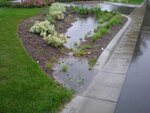

Each summer – and especially in recent years – Minnesota experiences some degree of drought. When it does rain, it’s best to keep rainwater on your property and allow it to soak into the ground, rather than running off into the street or alley. One great way to accomplish this is by adding a rain garden to your yard. Read on for rain garden tips and advice!
When rainwater runs off roofs, lawns, sidewalks, and driveways, it picks up pollutants and carries them into nearby storm drains, and ultimately, into our lakes and rivers. On the other hand, when rainwater soaks into the ground, it is filtered through the soil, where it can be used by plants or enter groundwater aquifers. This is referred to as “stormwater infiltration.” Rain gardens are an excellent tool to increase stormwater infiltration in your yard – and they can also prevent erosion, reduce flooding, attract pollinators and wildlife, and provide a beautiful low-maintenance garden bed.
Essentially, a rain garden is a low-lying garden bed with plants that can tolerate standing water. A great place for a rain garden is at the bottom of a downspout, to catch water running off your roof (however, keep in mind that rain gardens should be at least 10 feet away from any buildings to prevent water damage to basements, so you may need to extend your downspout to direct water an appropriate distance). The next time it rains, pay attention to any areas where water collects around your house. A rain garden can be placed where water naturally collects – or it can be placed strategically to draw water to a different area if you prefer. A rain garden is generally between 4 and 10 inches deep, and bowl-shaped with a relatively flat bottom for maximum water absorption. Make sure to call 811 and have utility lines marked before you start digging!
When designing a rain garden, look for plants that are native to our region, and that can tolerate standing water for at least 48 hours. Some excellent rain garden plants include Purple Coneflower, Joe-Pye Weed, Prairie Blazing Star, Cardinal Flower, and Little Bluestem. There are also some shrubs and small trees that can thrive in a rain garden, such as Serviceberry and Chokecherry. For a much longer list of rain garden plants with information on bloom time, sun requirements, mature height, and more, take a look at the publication “The Best Plants for 30 Tough Sites,” available for free on the University of Minnesota website.
Rain gardens are generally low maintenance because they use deep-rooted native plants that naturally thrive in our climate. However, a bit of work is needed the first couple of years to ensure that your carefully planted rain garden has a solid foundation. First – the rain garden needs water to help the new plants become established. Aim to provide about 1 inch of water per week (or less, if it rains). It’s also good to keep the garden mulched for the first year or two to retain moisture until the plants are more mature. Additionally, it’s important to do some weeding while the raingarden plants are small, to ensure that weeds don’t take over and crowd out your carefully chosen plants. Once the rain garden is established, it should need much less watering and weeding than non-native plantings – but it’s important to give it a hand while it matures to ensure a healthy and robust foundation!
There are many excellent resources for Minnesota raingarden information, including the Mississippi Watershed Management Organization, Blue Thumb, Metro Blooms, the Minnesota Pollution Control Agency, the Minnesota Department of Natural Resources, and the Minnesota Board of Water and Soil Resources. For example, Blue Thumb maintains a list of partner organizations and businesses that can help you design, install, and maintain a rain garden, and holds online trainings to learn more about planting for clean water and pollinator habitat. And the Board of Water and Soil Resources has a grant program called Lawns to Legumes that can provide funding for installing a rain garden with pollinator habitat.
Finally, if you don’t have a good spot for a rain garden, don’t despair! Installing a rain barrel provides some of the same benefits by reducing runoff and keeping rainwater on your property for use in watering ornamental plants.
For more information, check out the University of Minnesota Extension Yard and Garden website. Extension resources are written by experts, and contain the latest and most reliable research-based information. Happy gardening!
Comments
No comments on this item Please log in to comment by clicking here